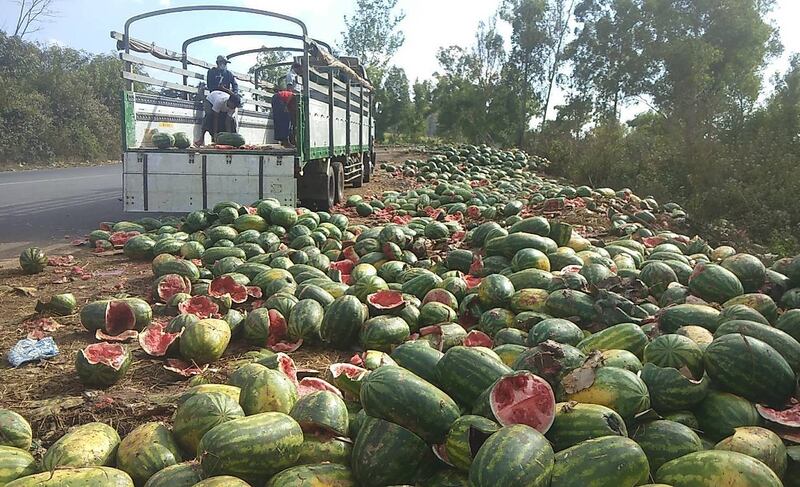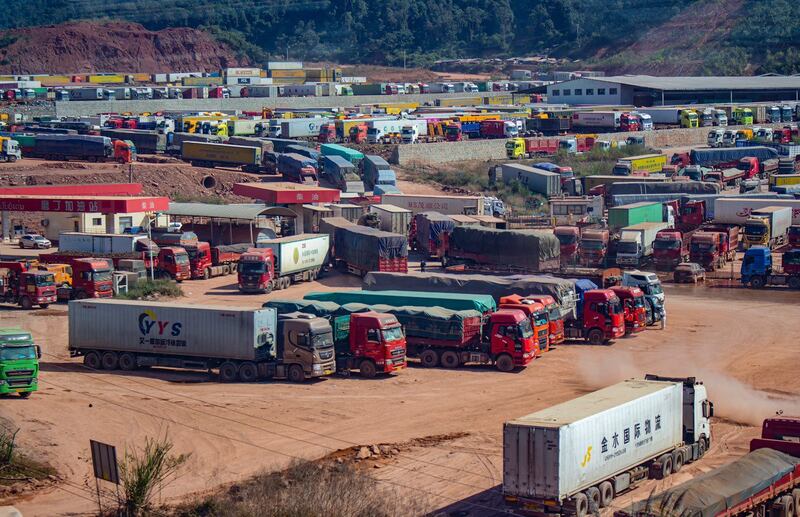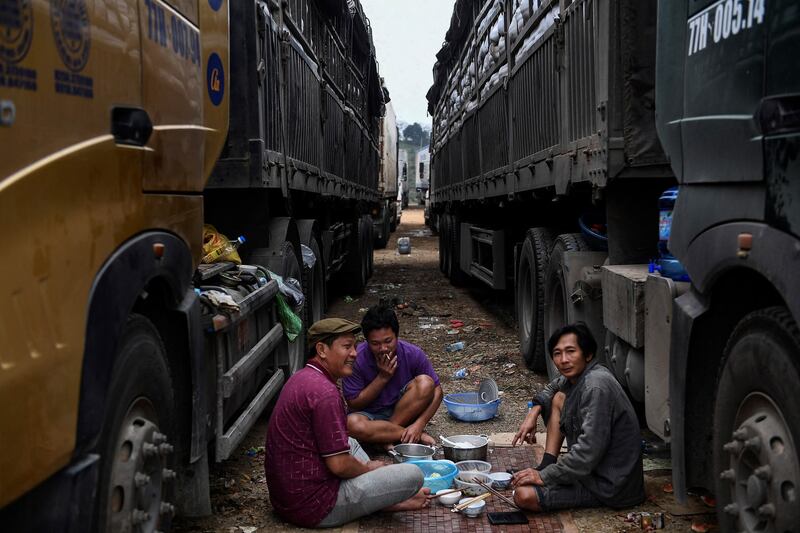Fresh watermelons from Myanmar left to rot. Truckers trapped in long lines getting into fistfights. Trailers full of dragon fruit stuck in Vietnam.
China’s strict border controls imposed to prevent Covid-19 ahead of next month’s Beijing Winter Olympics and keep a lid on an outbreak in Xi’an, a central Chinese city of 13 million people that began a complete lockdown last month, are causing major economic headaches for its neighbors and the workers there who depend on trade for their livelihoods.
Long lines of trucks are a fixture in Myanmar, Laos and Vietnam, leaving the agricultural products the vehicles carry to spoil, raising concern that there won’t be enough fruit to meet demand for the Lunar New Year holiday in late January.

Nearly every day, villagers from the town of Mong Yu in Myanmar wade through a pile of watermelons, looking for a few that are still fresh enough to eat. The cows and buffaloes that join in the feast are much less discriminating.
Either way, the circumstance is bad for the truckers and farmers who depend on the fruit trade to make a living. The daily ritual at a border crossing shows the importance to Myanmar and other Southeast Asian countries of the buying power of Chinese consumers.
The new border restrictions, which require the use of Chinese trucks to carry cargo across the border, have made it almost impossible to deliver the fresh fruit from Myanmar before it spoils, traders said. Truckers have been forced to dump their cargo and now stand to face huge losses.
“It now takes more than 15 days to move fruit from the sales depot here to the gate, and the fruit that has no guarantee for freshness cannot be exported,” Nang Kham Khin, the owner of the Sai Myint Bo Fruit Depot inside trade zone at the border, told RFA’s Myanmar Service.

Chinese trucks only
Sai Myint Bo said that the cost of export has also increased because Myanmar traders now must hire Chinese truck drivers to move their product across the border.
“Because of the high cost of the trucks and the high tariff rates on the Chinese side, we have to sort the fruit that comes to us, which is why there are so many rejects here,” he said.
The border checkpoint in Muse township had been closed for more than five months due to COVID-19, and it reopened on Nov. 26. But the stricter rules have caused delays.
They are also eating into the pockets of the produce sellers. A 12-wheeler from China rents for more than 6 million kyat (U.S. $3,300), whereas a similarly sized truck from Myanmar costs about 800,000 kyat (U.S. $450). Traders that cannot afford the drastic difference in shipping costs are simply abandoning their fruit at the border, Khun Min Thant, a border trader in Muse, told RFA.
“The fruit farmers want their products to get across as quickly as possible. If you cannot get a truck, you cannot sell your fruit quickly. That’s the problem,” he said.

To some sellers, the delays are still worth it. Many Myanmar watermelon farmers try for the border because they can get a higher price for their product in China.
“They can only get 1.5 to 2 million kyats for the fruit in Myanmar, but on the Chinese side, the price is much higher,” Kyaw Lin, a fruit trader from Myanmar’s largest city Yangon, told RFA.
Many of the watermelon exporters are Chinese traders who invested in Myanmar over the last year and they own brokerage houses near the border that pays farmers to grow the fruit for them.
The backup at the border gates total more than 500 watermelon trucks trying to unload their cargo in the Muse fruit depot, Kyaw Lin said.
Zaw Min Tun, deputy information minister and spokesman for Myanmar’s military government, told RFA that efforts were being made to eliminate the delays.
“COVID regulations will not be relaxed by the Chinese side,” he said.
“China is helping truck drivers and exporters speed up the testing of the virus for their products,” said Zaw Min Tun. “I am sure we will be able to do it faster in the future, despite the limitations.”
RFA attempted to contact officials at Myanmar's Ministry of Commerce over the phone but were unable to reach them. RFA also contacted the Chinese Embassy in Yangon by email, but received no response.
RFA attempted to contact officials at Myanmar’s Ministry of Commerce over the phone but were unable to reach them. RFA also contacted the Chinese Embassy in Yangon by email, but received no response.
Chinese Foreign Ministry spokesman Wang Wenbin defended tough controls as an essential part of China’s “strategic victory in the fight against COVID-19 at home” that would ensure a safe Winter Olympics in February.
"China adopts necessary COVID-19 protocols in light of the global COVID-19 situation with a responsible attitude toward the life and health of Chinese and foreign citizens. China’s huge food consumer market is open to all countries,” he told a news conference in Beijing on Tuesday,, saying he did not have details on specific border closure problems.
Line cutters spark brawl
Farmers and truckers in Myanmar aren’t the only ones being affected by tighter controls on China’s 3,900-km (2,400-mile) land border with Southeast Asia.
Long truck lines in Laos led to a fist fight at the Boten border gate in Luang Namtha province on Tuesday, after a Chinese truck driver cut in front of a Lao truck driver while both were queuing to enter a waiting area on the border to China.
“The rules do not allow drivers to cut in front of other drivers, but the Chinese driver cut in front of the Lao driver,” a Lao driver who witnessed the incident told RFA’s Lao Service.
“The Lao driver got angry and grabbed a stone and threw it at the Chinese truck, then the Chinese driver stopped the truck and came out to look at the damage. Then he hit the Lao driver in the head,” he said.
The source noted that fights between Lao and Chinese drivers occur often because many of the workers at the processing gate are Chinese and show preferential treatment to the drivers from China.

Another Lao truck driver said that the Chinese drivers use this privilege to cut in line, infuriating the Lao drivers, but tensions were higher than normal.
“This time, because there are so many trucks lined up, everybody wants to go first,” the second Lao truck driver said.
The lines extend from Boten for about 20-30 kilometers (12-18 miles), passing through Nateui village, a resident of the village told RFA.
“Everywhere we go it’s hard for even motorcycles or cars to maneuver with all the trucks lining up for the gate to China,” the villager said.
“Officials are trying hard, but the drivers are all cutting in front of each other to get in first,” said the villager.
An official from Luang Namtha told RFA that the local government is attempting to solve the backup.
“All the related sectors are cooperating with each other to solve the problem. In the future we will have shipping containers sent via rail,” the official said.
The recently completed Laos-China high speed railway between Vientiane and Boten is expected to be a much cheaper shipping alternative to trucking, and shipments of rail cargo has already begun, the official said.
But before cargo trains start rolling in earnest, only 150 trucks can pass through the Boten gate in either direction each day, while there are 350 trucks waiting on each side, and the lines are expected to grow longer.
The trucks must be sprayed three times to stop the spread of COVID-19 within 20 minutes of crossing the border, and the gate is only open from 8 a.m. to 4 p.m., excluding holidays.
RFA previously reported lines as long as 1,000 trucks, extending 45 kilometers (28 miles) into neighboring Oudomxay province.

Contaminated fruit
Chinese authorities shut down supermarkets in nine cities in the southeastern provinces of Zhejiang and Jiangxi after traces of COVID-19 were found in dragon fruit imported from Vietnam, the South China Morning Post reported Thursday.
The discovery comes after China already placed a ban on Vietnamese dragon fruit from Dec. 29 to Jan. 26, when COVID-19 was detected the imported fruit in the last week of December.
The Vietnamese Ministry of Agriculture and Rural Development said that traders could have trouble selling 300,000 tons of dragon fruit produced for the upcoming Lunar New Year, a major holiday in China which falls on Feb. 1.
Sales of dragon fruit in 2021 reached almost $1 billion, said Le Than Hoa, the deputy director general of MARD’s Agro Processing and Market Development Authority.

The farm ministry is advising farmers and businesses in the northern Vietnamese provinces of Quang Ninh and Lang Son to stop exports to China coming out of these provinces.
Local media reported that as of Thursday around 3,000 Vietnamese trucks which were waiting to cross the border into China, most of which were carrying agricultural goods. An estimated 1,700 were said to be carrying dragon fruit, jack fruit, mango, and watermelon.
The ministry advised businesses and farmers to find measures to export agri-products via railway, by sea and also promote local consumption.
The Vietnamese Trade Ministry on Jan. 2 asked Chinese authorities in Guangxi, the region bordering Vietnam, to take urgent measures to ease congestion.
Guangxi authorities responded saying they would allow more time for customs clearance and alert higher authorities, local media reported.
Translated by Khin Maung Nyane, Sidney Khotpanya and Thi Chau. Written in English by Eugene Whong.
